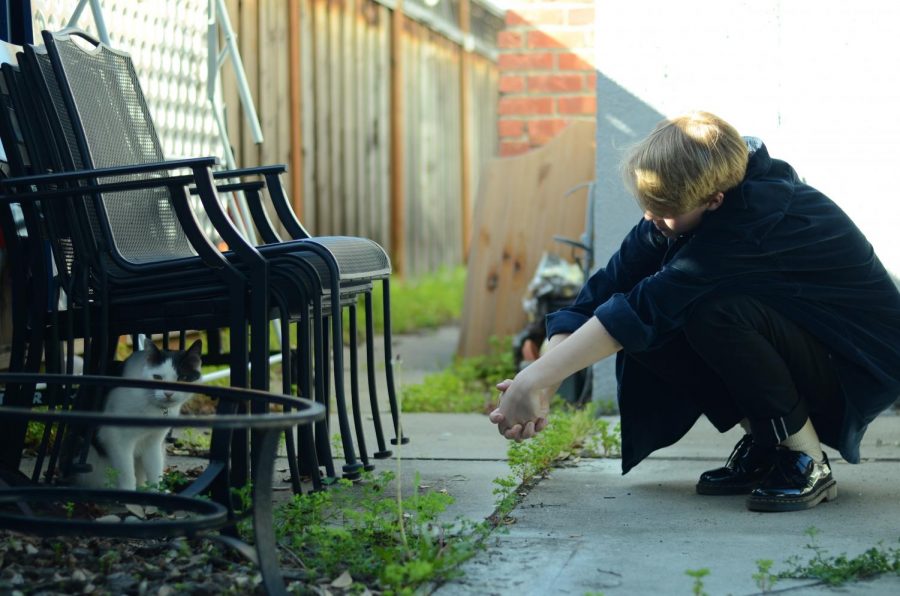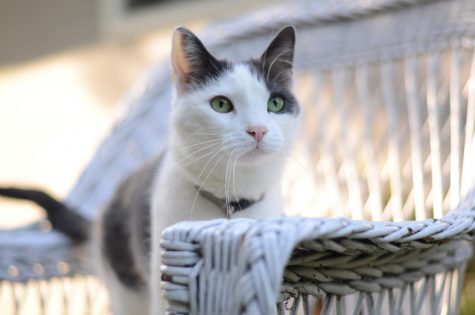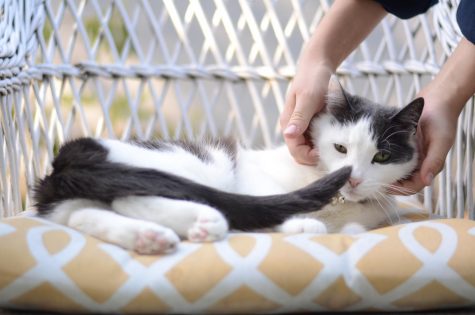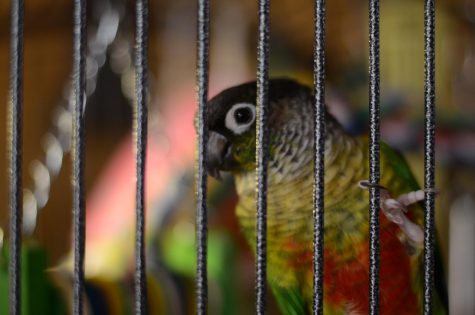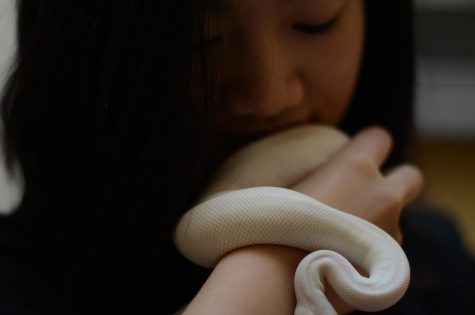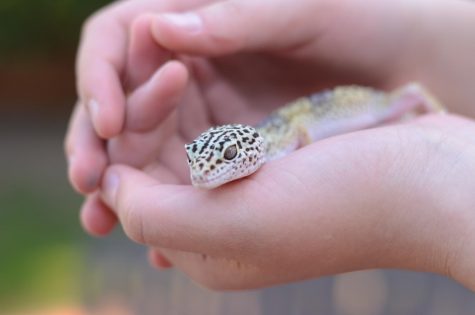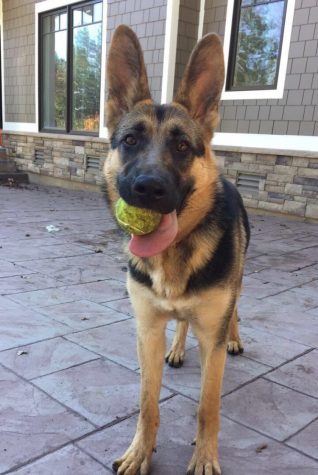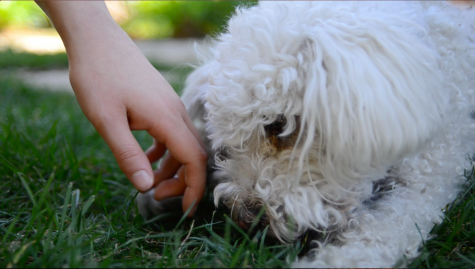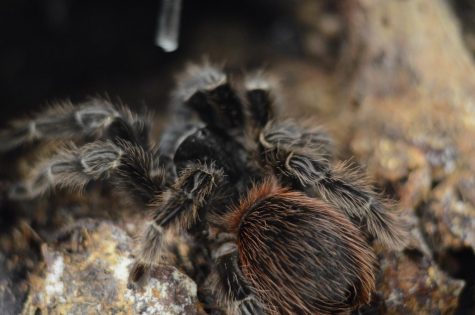Pets of Harker
Elliot Kampmeier (9) crouches down beside a stack of chairs and one of his cats. “My dad’s coworker runs a cat shelter, just out of his house, so we got both of our cats from him. It’s really funny, because he used to play minor league baseball, so he’s this really buff, tall guy, and there’s pictures of him bottle feeding little kittens so it’s really great,” he said.
With all the stress and pressure that comes with being a high schooler, many students turn to their furry friends for comfort and support. As a listening ear, a loyal companion, and a way to connect with nature and the environment, pets are some of our closest friends. Even many pet-loving teachers introduce them as learning tools in the classroom. “It definitely makes this more than just a chemistry classroom, I think it makes it a generalized science classroom,” chemistry teacher Andrew Irvine said. “It’s been an interesting way to explore science and biology, and just animals in general, and it’s just kind of a passion of mine, to raise and take care of or even breed these animals,”
Elliot Kampmeier, Angel, and Dr. Nefario:
Elliot Kampmeier (9) owns two cats: Angel and Dr. Nefario, which he and his family bought to replace their old cats once they moved to California from New Jersey. Angel, always the lady, is the more mature of the two. Warm, loving, and always up to listen to Elliot’s ramblings, she spends her days lounging around the house with catnip or trying to escape the antagonizing dog next door. Nefario is the more adventurous of the two, always trying to assert his dominance over the neighborhood cats (the alpha is obviously Angel, but he hasn’t taken the clue yet). He’s a sweet friend to everyone he meets, Except for squirrels, which he enjoys chasing. Elliot thinks that arguably the worst part about owning cats is randomly waking up to piles of vomit.
Katelyn Chen and her 5 pets:
Katelyn Chen (10) is an avid animal-lover, owning five pets including a turtle, a ball python, a bird, and a couple of fish. She has a heart-warming care and love for each of her animals, despite her bird’s tendency to bite her, her snake’s often mysterious whereabouts, and her turtle’s affinity for eating random objects that fall into the water. Ollie, her green sheet conure, is an often frazzled, nervous bird. Easily the most colorful of the animals, Ollie can be found either frantically pecking at random objects or doing some kind of bird yoga in her cage. Blue, being a nocturnal snake, is the grumpy old man of snakes. Extremely grumpy and sluggish if seen during the day, but transforms into a fierce predator by night. His diet consists mostly of frozen mice. Katelyn hopes to go into veterinary medicine in the future.
Lou Sanche and Matcha, Oakley, and Galileo:
Lou Sanche (11) owns a cat named Matcha, a dog named Oakley, and a gecko. His dog and his cat seemed to have switched personalities, as Matcha wags her tail whenever she’s happiness, and Oakley can often be found sunbathing or grooming himself, or being jealous of the attention Matcha gets. Galileo, the leopard gecko, is as prickly as his skin and mostly just sits around staring judgmentally at the other animals. As someone who struggles with social anxiety, Lou finds that his pets, especially his emotional support dog, helps calm him down, mostly by piling around him. He loves reptiles and large dogs, and in the future, he hopes to possibly own a Rottweiler.
Taylor Lam and Mushu and Sparky:
Taylor Lam (11), as a present for completing her ACT, received a dog which she named Mushu, a German Shepard. Her first love, though, is her chinchilla, Sparky. Despite his love for running freely around the house, Sparky can mostly be found in his cage, and has a strange affinity for sitting on Taylor’s shoulder while she’s studying.
“I wanted to rescue a dog because I’m just in general a big dog lover, so it didn’t really matter to me what the dog looked like, or what breed as long as it had a good personality and was friendly, then I think that I could come to love any dog,” she said.
Amy Dunphy and Hermes and Rabbit:
Amy Dunphy’s (12) dog Hermes is a ball of sunshine brighter that his white, curly fur. The always hyper ball of energy greets everyone with limitless excitement and fervor. Her rabbit, unironically named Rabbit is the polar opposite of Hermes: shy, reserved, and, as Amy is convinced, evil. She claims her rabbit’s beady red eyes are always glinting with the possibility of taking of the world. Coming from a family of animal lovers, Amy has a unique and heartwarming relationship to all the animals around her neighborhood.
Andrew Irvine and his classroom friends:
Chemistry teacher Andrew Irvine has eccentric pets to match his eccentric personality, owning a bibron gecko, four fire belly toads, a scarlet bird-eating tarantula, a Russian tortoise, four poison dart frogs, a rat snake, and a pair of baby tarantulas. The self-proclaimed ‘secret biologist’ and Hagrid of Harker, Irvine believes that any classroom with the critter in the corner is enhanced in unimaginable ways, and that breeding and owning animals in the classroom lets him and his students explore more outside of the sphere of chemistry in his classes. As a father, he uses his animals to teach his five-year-old daughter responsibility.
“We live in this like garden of eden of critters and animals and I think as humans and intelligent species, we have a responsibility to understand and care for our fellow earthlings, and so I think that it’s good for the students to see that part of science.” He said, “It’s one thing to learn about frogs in a textbook, or see frogs on the internet, or cut open a dead frog, but how do you take care of them? What do they eat? What are their behaviours? How do they breed? What do they need to be alive, and that all connects to chemistry and biology and even physics.”
This piece was originally published in the pages of The Winged Post on May 7, 2018.
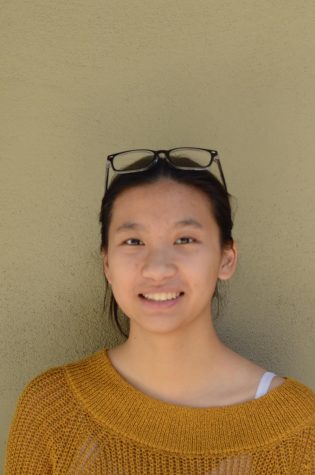
Nina Gee (12) is the co-design editor for the Winged Post. This is her fourth year on the Harker Journalism staff. An aspiring filmmaker and avid storyteller,...


















![“[Building nerf blasters] became this outlet of creativity for me that hasn't been matched by anything else. The process [of] making a build complete to your desire is such a painstakingly difficult process, but I've had to learn from [the skills needed from] soldering to proper painting. There's so many different options for everything, if you think about it, it exists. The best part is [that] if it doesn't exist, you can build it yourself," Ishaan Parate said.](https://harkeraquila.com/wp-content/uploads/2022/08/DSC_8149-900x604.jpg)




![“When I came into high school, I was ready to be a follower. But DECA was a game changer for me. It helped me overcome my fear of public speaking, and it's played such a major role in who I've become today. To be able to successfully lead a chapter of 150 students, an officer team and be one of the upperclassmen I once really admired is something I'm [really] proud of,” Anvitha Tummala ('21) said.](https://harkeraquila.com/wp-content/uploads/2021/07/Screen-Shot-2021-07-25-at-9.50.05-AM-900x594.png)







![“I think getting up in the morning and having a sense of purpose [is exciting]. I think without a certain amount of drive, life is kind of obsolete and mundane, and I think having that every single day is what makes each day unique and kind of makes life exciting,” Neymika Jain (12) said.](https://harkeraquila.com/wp-content/uploads/2017/06/Screen-Shot-2017-06-03-at-4.54.16-PM.png)








![“My slogan is ‘slow feet, don’t eat, and I’m hungry.’ You need to run fast to get where you are–you aren't going to get those championships if you aren't fast,” Angel Cervantes (12) said. “I want to do well in school on my tests and in track and win championships for my team. I live by that, [and] I can do that anywhere: in the classroom or on the field.”](https://harkeraquila.com/wp-content/uploads/2018/06/DSC5146-900x601.jpg)
![“[Volleyball has] taught me how to fall correctly, and another thing it taught is that you don’t have to be the best at something to be good at it. If you just hit the ball in a smart way, then it still scores points and you’re good at it. You could be a background player and still make a much bigger impact on the team than you would think,” Anya Gert (’20) said.](https://harkeraquila.com/wp-content/uploads/2020/06/AnnaGert_JinTuan_HoHPhotoEdited-600x900.jpeg)

![“I'm not nearly there yet, but [my confidence has] definitely been getting better since I was pretty shy and timid coming into Harker my freshman year. I know that there's a lot of people that are really confident in what they do, and I really admire them. Everyone's so driven and that has really pushed me to kind of try to find my own place in high school and be more confident,” Alyssa Huang (’20) said.](https://harkeraquila.com/wp-content/uploads/2020/06/AlyssaHuang_EmilyChen_HoHPhoto-900x749.jpeg)



